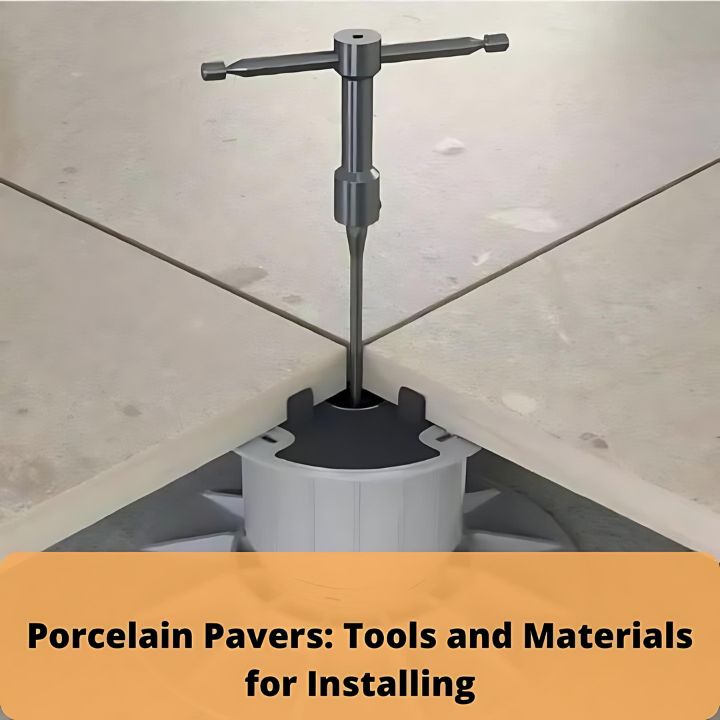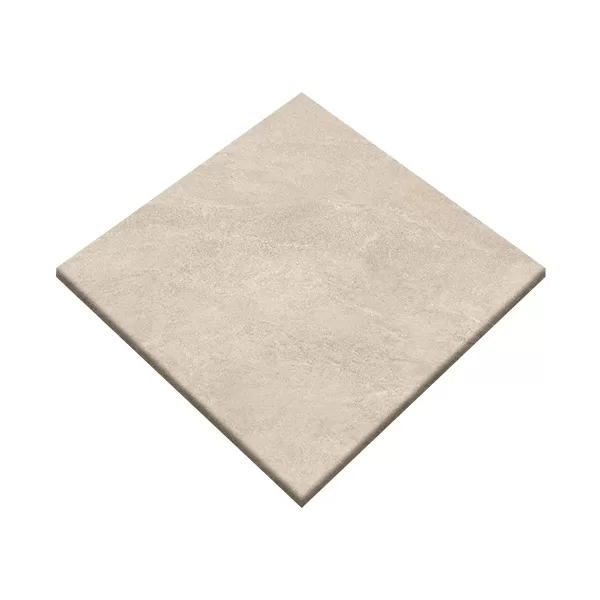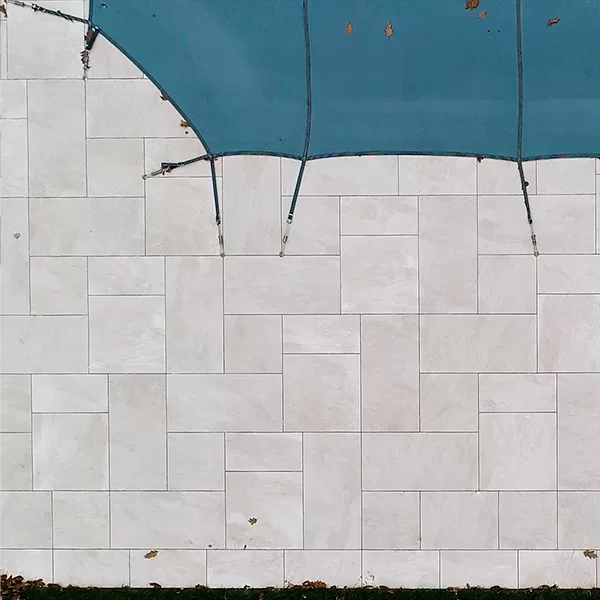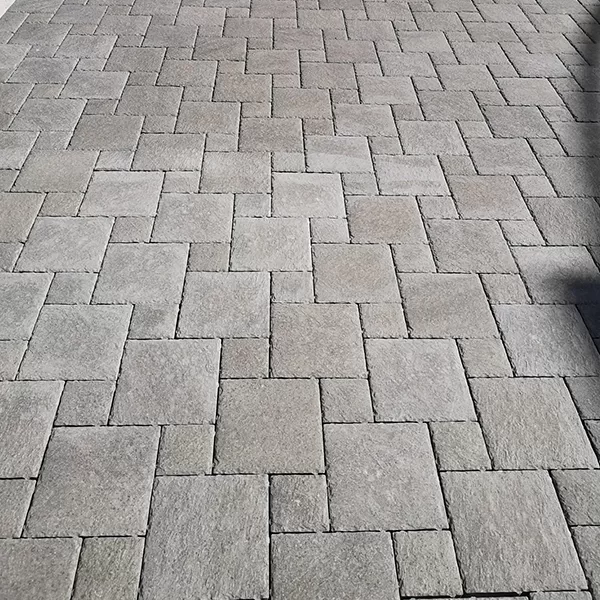Transforming your outdoor space with the elegance and sophistication of porcelain pavers combines robust functionality with aesthetic appeal. Whether you’re enhancing a patio, pool deck, or driveway, the success of porcelain paver installation hinges on the precise selection of tools and materials.
From the reliable impact of a rubber mallet to the precision provided by spacers, each tool and material plays a crucial role in the quality of the finished project. Selecting the right porcelain pavers involves a blend of technical expertise and design insight, ensuring that every choice contributes to the overall beauty and durability of the space.
Continue reading to discover the essential tools and materials needed for a successful porcelain paver installation, and learn how to achieve a flawless and stunning outdoor area.
Key Takeaways
- Proper Preparation and High-Quality Materials Are Crucial for a Durable Porcelain Paver Installation
- Precision Tools and Cutting Techniques Are Essential for Achieving a Seamless Porcelain Paver Fit
- The Right Grout and Sealant Selection Enhance Both the Aesthetic and Structural Integrity of Porcelain Pavements
- Regular Maintenance With Appropriate Tools and Cleaners Is Imperative to Preserve the Appearance and Lifespan of Porcelain Pavers
- A Meticulous Installation Process and Ongoing Care Ensure Porcelain Pavers Remain a Stunning Addition to Any Outdoor Space
Essential Tools for Porcelain Paver Installation
Embarking on a porcelain paver installation offers an architect or homeowner an opportunity to transform any patio, pool deck, or walkway into an elegant oasis.
The allure of porcelain pavers lies in their low water absorption rates, durability, and extensive design options.
To ensure a successful installation, one must be equipped with specific tools that facilitate precision and efficiency throughout the installation process.
From the initial excavation to the final touches of the jointing compound, every piece of equipment and material plays a pivotal role in achieving a flawless finish.
Whether the project involves a tranquil garden walkway or a bustling plaza, the right set of tools is indispensable for tile installers aiming for excellence.
essential tools
The journey toward installing porcelain pavers begins with assembling a suite of indispensable tools. Tile installers must be resourced with precision instruments such as a spirit level, which is essential for confirming surface evenness and avoiding ill-fitting pavers:
| Tool | Function |
|---|---|
| Spirit Level | Ensure even surfaces |
| Diamond Blade | Precise cutting of pavers |
| Shovel | Excavate and prepare substructures |
| Rubber Mallet | Gently settle pavers into place |
| Trowel | Apply adhesive and mortar bed smoothly |
| Spacers | Maintain uniform gaps between pavers |
| Plate Compactor | Consolidate gravel base and sand bed |
Next, a high-quality diamond blade attached to power tools becomes a crucial ally, enabling the installer to execute accurate cuts through the robust porcelain without causing breakage. Maintaining a set of robust hand tools, including shovels for ground preparation or a rubber mallet for gentle paver placement, also contributes greatly to an installation’s success.
installation process
The installation process for porcelain pavers is a meticulous operation that commences with a thorough surface preparation: the area must be excavated to an appropriate depth and then layered with a gravel base to ensure stability and adequate drainage capacity. Following this, the installer spreads a sand base or mortar bed to create a level and supportive foundation for the porcelain tiles.
- Excavate the area to the required depth.
- Install a gravel base to enhance stability and drainage.
- Apply a layer of sand base or mortar bed for support.
Once the groundwork is prepared, placement of the porcelain paver units begins, guided by the careful use of spacers to ensure uniform joints. Each paver is gently tapped into place with a rubber mallet, confirming strong adhesion and proper alignment. This step is critical in avoiding any irregularities across the patio or walkway.
Choosing the Right Materials
Securing the ideal selection of porcelain pavers and materials is not merely about aesthetics but also structural integrity and long-term durability.
Contractors and homeowners must invest in high-quality porcelain pavers, revered for their resistance to cracking and minimal water absorption.
They must also gather materials that reinforce the strength and reliability of the installation method, such as the right grade of grout, adhesives with superior adhesion properties, and gravel with appropriate compaction qualities.
Balancing beauty with functionality, the journey to a resplendent patio or terrace begins with choosing products designed to endure the rigors of both foot traffic and natural elements.
importance of selecting high-quality porcelain pavers
Selecting high-quality porcelain pavers is a commitment to longevity and performance in any outdoor space. These pavers withstand a variety of climatic stresses, and their low water absorption rate mitigates the risk of frost damage in colder regions:
- Quality porcelain pavers resist extreme temperatures, preventing cracking and ensuring structural integrity.
- The reduced water absorption of premium pavers guards against the freeze-thaw cycle, offering peace of mind in variable weather conditions.
Additionally, exceptional porcelain pavers, through their advanced manufacturing process, possess a uniform and dense constitution that grants them superior strength against breakage from high-traffic areas or heavy loads, ensuring the terrace or driveway remains impeccable over time.
necessary materials
Achieving the perfect balance between form and function requires not only selecting premium porcelain pavers but also ensuring the accompanying materials are conducive to a resilient and lasting installation. Installers must employ a jointing compound that complements the strength and aesthetic of the porcelain, preventing weed growth and water ingress between the pavers.
Integral to the stability of porcelain paving is the foundation, where using a paver base of the correct specification will underpin the entire structure. This base should adequately support the pavers and facilitate proper drainage, thus safeguarding the integrity of the hardscape against shifting and settling.
Preparing the Base: Materials and Method
Initiating the installation of porcelain pavers with attention to detail starts fundamentally at the base—where the robustness of the entire patio or walkway is determined.
Choosing the right base materials is critical for ensuring a stable and enduring surface that can effortlessly accommodate the elegance of porcelain tiles.
A well-prepared base is not only a guarantee for the longevity of the pavers but also impacts the overall appearance and functionality of the outdoor area.
Each material, be it crushed stone, gravel, or a concrete slab, serves a distinct purpose in creating a secure platform for the porcelain pavers that will remain unyielding through seasons and usage.
preparing the base for porcelain pavers
Beginning with the right base preparation is the cornerstone of any successful porcelain paver installation. Contractors meticulously excavate the area, removing topsoil and creating a bedrock of stability with a meticulously compacted gravel base that both supports the pavers and facilitates essential drainage.
Utilizing precision tools like a plate compactor, professionals consolidate the base materials, which often include a layer of sand or a mortar bed, ensuring a flat, level groundwork. The strategic placement of these layers is pivotal to prevent settling and movement, providing a steadfast foundation for the porcelain pavers to rest upon.
types of base materials
Identifying the optimal base materials forms the backbone of porcelain paver installation, with each choice impacting overall stability and durability. A solid concrete base offers rigidity and uniformity, commonly used for areas expecting significant pedestrian use or heavy furniture, such as terraces and public plazas.
In contrast, a sand bed presents a flexible solution that adapts to soil conditions while facilitating proper drainage, ideal for areas like garden paths or residential driveways. These materials, selected with care, form the substructures that ensure porcelain pavers retain their position and aesthetic appeal over time.
Cutting Porcelain Pavers: Tools and Techniques
Crafting the perfect outdoor oasis with porcelain pavers requires more than just laying the pieces; it demands precision in cutting the material to fit the unique contours of the project space.
Mastery in slicing through these durable pavers is gained through an understanding of the correct techniques and the use of specialized tools.
Cutting porcelain pavers to seamless perfection elevates the overall look, ensuring straight edges and tight joins that accentuate the area’s harmony.
Installers and contractors must wield their tools with confidence and skill, as they navigate through these tips for exact cuts—each meticulous notch and trim bringing them closer to an immaculate finish.
how to properly cut porcelain pavers
Properly cutting porcelain pavers demands precision and conscientious handling, wielding a wet saw equipped with a diamond blade designed explicitly for porcelain material. An installer must measure and mark the paver before carefully guiding it through the saw, ensuring the blade remains wet to minimize dust and reduce the risk of overheating, which can compromise the quality of the cut.
The technique is equally as important as the tool itself; maintaining a steady hand and even pressure allows the blade to make a clean, accurate incision. This process often necessitates multiple, gentle passes rather than a single forceful cut to avoid chipping the edges or causing breakage of the paver, securing an exquisite fitting within the intended space.
Tips for achieving precise cuts
When undertaking the task of porcelain paver installation, obtaining cuts of remarkable precision is not left to chance. Each meticulous incision is a testament to the installer’s ability to balance meticulous measurements with the finesse required for slicing through the high-density tile.
For professionals intent on exceptional workmanship, adherence to measured guidelines is paramount: marking each porcelain paver with precision ensures the blade’s path follows an exact trajectory. Consequently, even complex shapes or snug corners become achievable sections of the grand design:
- Measure the paver to determine the exact size required.
- Mark the porcelain paver using a non-permanent, visible tool.
- Align the paver on the wet saw table with the cutting guide.
- Execute the cut following the marked line, applying steady pressure.
- Finish by smoothing any rough edges for a clean integration into the layout.
The expert tilers employ a series of careful techniques combined with acute attentiveness to detail to ensure that each porcelain paver interlocks seamlessly. Their proficiency with cutting tools fortifies the enduring elegance of every completed project, from lavish balconies to sophisticated rooftops.
Laying the Porcelain Pavers: What You’ll Need
Setting the stage for a pristine porcelain paver space, whether it be a tranquil backyard or a regal roof deck, hinges on the delicate interplay between the right tools, materials, and laying techniques.
The craft of laying porcelain pavers is analogous to a ballet of precise movements, blending the strategic use of spacers, trowels, and porcelain tiles to produce an interlocked surface that is as durable as it is captivating.
Before the dance begins, however, one must stock their arsenal with the essentials—each tool and material selected with care, each technique honed for the task.
The marriage of these components underpins the ease of installation and longevity of the outdoor sanctuary, as every spacer placed and paver laid builds towards the creation of an enduring, picturesque expanse.
tools and materials needed for laying the pavers
When it comes to laying porcelain pavers, the installer’s toolbox should be brimming with specialized implements tailored for this delicate task. Essentials such as a top-tier thin-set adhesive offer a steadfast grip, ensuring each paver remains secure against the elements and regular use on the hardscape.
Of equal importance are the paver accessories that aid in the precision of the layout; tile spacers aid in achieving an evenly spaced design, while a long-handled rubber mallet allows for the alignment of pavers without damage. Together, these tools and materials collaborate to orchestrate a porcelain pavement installation that embodies durability and aesthetics.
technique for laying porcelain pavers
The precise technique of laying porcelain pavers begins with an even application of thin-set adhesive or a mortar bed with a notched trowel. The installer ensures that each paver is placed with deliberate attention to the prescribed spacing, incorporating a level to verify that no tile sits higher than its neighbors, maintaining a cohesive and uniform surface throughout.
To solidify the positioning, tile installers align and press each porcelain piece firmly into the adhesive bed, taking care not to slide the pavers, which could disrupt the even setting of the chipset. As each unit is laid, a rubber mallet is gently utilized to embed the paver securely, confirming adhesion without inflicting any cracks or damage to the porcelain’s integrity.
Grouting and Sealing: Materials and Application
Upon expertly laying porcelain pavers, one arrives at a crucial juncture in the installation journey — grouting and sealing.
This stage is not to be underestimated, as it reinforces the integrity and enhances the beauty of the hardscape.
Selecting a type of grout that aligns with the porcelain paver’s attributes is pivotal; it must be robust enough to withstand environmental pressures while complementing the tile’s aesthetic.
Equally important is the sealing process, a protective measure that acts as the final defense against staining and wear.
Together, grouting and sealing are the capstones that ensure the completed project stands the test of time and usage.
types of grout suitable for porcelain pavers
The type of grout chosen for porcelain paver installation is critical to both the aesthetic and structural integrity of the surface: it must correlate with the paver’s strength and offer resistance against various environmental factors. For porcelain pavers, sanded or unsanded grout can be used based on the width of the joints; wider joints typically call for sanded grout due to its enhanced bonding ability, which helps prevent cracking.
| Joint Width | Recommended Grout Type |
|---|---|
| Narrow (< 1/8 inch) | Unsanded Grout |
| Wide (> 1/8 inch) | Sanded Grout |
In the realm of porcelain paver installation, epoxy grout is heralded for its robust composition and longevity: epoxy resists stains and does not require sealing, making it a premium choice for areas with high moisture or where stains are a concern. This type of grout, while more challenging to work with than traditional grout products, rewards the homeowner and the installer with its enduring qualities and minimal maintenance requirements.
importance of sealing pavers
The application of a sealant is a crucial safeguard following the laying and grouting of porcelain pavers; it forms an impermeable barrier that protects the surface from stains, weather damage, and everyday wear and tear. Proper sealing not only elongates the life of the pavers but also preserves their pristine appearance, making it an essential step for maintaining the investment’s value over time.
Sealing is especially vital in porous paver installations, where the potential for moisture ingress could lead to the proliferation of mold or moss, undermining the structure’s integrity and aesthetic. Contractors recognize that a high-quality sealant enhances the resilience of the pavers against such issues, ensuring that patios, driveways, and pool decks retain their intended splendor and functionality.
Maintenance Tools and Supplies
Once the porcelain pavers are immaculately installed and the landscape is transformed into a stunning display of architectural finesse, attention must then pivot to preservation.
Commitment to upkeep is paramount for retaining the allure and extending the lifespan of the hardscape.
Therefore, equipping oneself with the proper tools and supplies for regular maintenance becomes just as imperative as the installation itself.
From periodic cleaning regiments to the application of appropriate care products, tile installers and homeowners alike must become stewards of their investment, ensuring the porcelain pavers remain a testament to both beauty and endurance through continued vigilance.
tools and supplies needed for ongoing maintenance
Keeping porcelain pavers in top condition demands regular maintenance, which requires the deployment of specialized cleaning agents that are compatible with the unique properties of the porcelain. Employing a gentle, pH-neutral cleaner helps prevent damage to the sealant and ensures that the pavers do not lose their lustrous finish over time.
For an effective and meticulous cleaning routine, homeowners should seek tools such as a soft-bristled broom for removing debris and a squeegee suited for expelling water and cleaner from the surface. The use of a pressure washer, set to an appropriate and safe pressure level, can also be beneficial for dislodging embedded dirt and grime without compromising the integrity of the grout or the pavers.
regular cleaning for porcelain pavers
To maintain the pristine appearance of porcelain pavers, routine cleaning is essential. Homeowners should implement a cleaning schedule to regularly remove any debris or stains, ensuring that the porcelain’s surface remains impeccable and skid-resistant for pedestrian safety.
Utilizing non-acidic, soap-free cleaners for porcelain pavers preserves their look and prevents any harm to the sealant that safeguards the tile’s integrity. This proactive approach to maintenance assures that the pavers will continue to exhibit their natural beauty and robustness against the elements as the years pass.
Frequently Asked Questions
What are the essential tools needed for installing porcelain pavers?
Embarking on a porcelain paver installation project entails assembling a suite of specialized tools designed to handle the materials’ unique properties. These must-have items converge functionality with precision, aiding an installer from preparation to the final touches of laying down a luxurious and enduring surface.
To launch the installation process, an accurate area measurement is pivotal, ensuring that one acquires an adequate quantity of porcelain paver units. A tape measure, spirit level, and chalk line take their rightful place among essentials, granting the power to map out the designated space for the pavers, be it a patio, pool deck, or walkway.
As a homeowner or contractor mobilizes for the excavation of the ground, a shovel and pickaxe are your primitive yet indispensable tools. They facilitate the removal of topsoil and enable one to achieve the correct gravel base depth. Following the strategic excavation, a compact foundation is paramount, and a plate compactor becomes a non-negotiable piece in your arsenal; it solidifies the gravel base granting stability to the impending layer of porcelain tiles.
- Trowel and rubber mallet come in next, delivering finesse as the pavers are placed onto the bed of sand or adhesive.
- The spacer sits as another pivotal guide, dictating the uniformity of gaps that later will be filled with grout or jointing compound, ensuring everything is level and evenly spaced.
- For porcelain tiles that require cutting to accommodate corners, edges, or unique design options, a wet saw with a diamond blade is the tool of choice, cutting through the paver with precision, thus reducing the potential for breakage.
- When installation nears completion, a rubber squeegee aids in the even distribution of jointing compound, a critical step for the longevity and aesthetic of the patio or walkway.
For elevated areas such as balconies or roof decks, a pedestal system may be employed, which necessitates the use of additional hand tools to adjust the height and ensure the surface is even. The rubber mallet reappears here, tapping the paver tiles gently into place, perfecting the sublime terrace or plaza.
A pro tip: always refer to the manufacturer’s instructions or work under the guidance of a seasoned professional to validate that each step aligns with the product’s intended installation method.
In essence, the ideal outcome of a porcelain paver installation doesn’t solely rest on the choice of high-quality materials or the meticulous nature of the installer. It equally depends on the symphony of tools, each playing its role, from the shovel used to excavate the area to the accessories and finishing trims that pronounce the elegance of the finished hardscape.
How do I choose the right materials for porcelain paver installation?
Selecting the appropriate materials for porcelain paver installation hinges on factors such as the intended use of the space—be it a patio or a driveway—and the specific qualities of the product, including water absorption rates and the durability of the manufacturing process. Moreover, it is essential to contemplate both the aesthetic and functional needs, aligning them with the homeowner’s vision and the architect’s design options, ensuring a harmonious integration with the existing hardscapes.
What materials and methods are used for preparing the base before installing porcelain pavers?
Preparing the base for porcelain pavers typically involves an excavation to remove topsoil and the use of a gravel base for proper drainage capacity. Contractors might employ a sand bed or mortar bed as a leveler, ensuring a stable and flat surface for the installation of the pavers.
What tools and techniques are best for cutting porcelain pavers?
When considering the task of cutting porcelain pavers, a diamond blade-equipped saw stands out as the optimal tool, ensuring precision and mitigating breakage. Experts employ wet saws to diminish dust and improve the cut’s cleanliness, while manual snap cutters might suffice for straight cuts when a less refined edge is permissible.
What tools and supplies are needed for laying porcelain pavers?
Laying porcelain pavers, those who venture into turning their patios or pathways into masterpieces must gather a comprehensive toolkit. Essential tools include a rubber mallet, spacers, a trowel, and a spirit level to ensure even placement and a visually pleasing result.
Outfitting oneself adequately goes beyond these basics. A shovel and a plate compactor aid in preparing the substrate, encompassing the excavation of the area and crafting a stable gravel base. For precision cuts around the edges or to accommodate unique shapes, a diamond blade is indispensable.
In the realm of materials, porcelain pavers themselves are paramount, alongside a suitable adhesive or mortar, and jointing compound to secure the pavers and fill the spaces between them. Considering various substructures, an installer might also employ a pedestal system, especially for venues like roof decks, to ensure a level surface area and efficient drainage.
Contractors undertaking porcelain paving on large hardscapes might benefit from power tools to expedite the process, while hand tools allow for meticulous adjustments. Additionally, tile tools specialized for porcelain tile make handling and installation more efficient, reducing the likelihood of breakage.
Porcelain paver installation steps should be reinforced with detailed instructions, often sourced from the manufacturer or skilled tile installers, to guide the process from excavation to the final stages of grouting. Ensuring one emails the manufacturer to clarify any uncertainties regarding their product or its installation method is a pro tip that pays dividends in the execution of the project.
Beyond tools and supplies, a clear understanding of the manufacturing process, water absorption, and the character of porcelain paver units shape a homeowner’s approach to selecting the right product. Acknowledging the interplay between aesthetic preferences and functional demands, be it for a pool deck, walkway, or driveway, defines the enduring success of any porcelain pavers installation.
Conclusion
In conclusion, the key to a successful porcelain paver installation lies in the careful selection of specialized tools and premium materials. Precision tools such as a diamond blade, spirit level, and rubber mallet are indispensable for ensuring accurate cuts, level surfaces, and secure placement of each paver.
The foundation is equally important, with materials like gravel or sand forming a crucial base that guarantees the pavers’ stability over time. Opting for high-quality porcelain pavers, known for their resistance to extreme weather and low water absorption, is essential. Coupled with the right adhesives and grouts, they provide both an aesthetically pleasing and structurally sound finish.
Regular upkeep, using suitable cleaners and maintenance tools, plays a vital role in maintaining the hardscape’s beauty and safety. This combination of correct selection and application not only simplifies the installation process but also ensures that your outdoor spaces in New Jersey, or nearby areas, remain beautiful and durable for years to come.
For expert advice, quality materials, and all the tools you need for porcelain paver installation in New Jersey, we invite you to visit us at NT Pavers. Let us help you transform your outdoor spaces with the elegance and durability of porcelain pavers.





